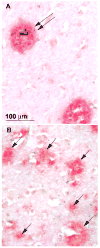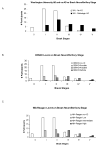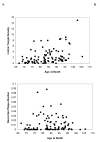Neuropathology of nondemented aging: presumptive evidence for preclinical Alzheimer disease
- PMID: 19376612
- PMCID: PMC2737680
- DOI: 10.1016/j.neurobiolaging.2009.04.002
Neuropathology of nondemented aging: presumptive evidence for preclinical Alzheimer disease
Abstract
Objective: To determine the frequency and possible cognitive effect of histological Alzheimer's disease (AD) in autopsied older nondemented individuals.
Design: Senile plaques (SPs) and neurofibrillary tangles (NFTs) were assessed quantitatively in 97 cases from 7 Alzheimer's Disease Centers (ADCs). Neuropathological diagnoses of AD (npAD) were also made with four sets of criteria. Adjusted linear mixed models tested differences between participants with and without npAD on the quantitative neuropathology measures and psychometric test scores prior to death. Spearman rank-order correlations between AD lesions and psychometric scores at last assessment were calculated for cases with pathology in particular regions.
Setting: Washington University Alzheimer's Disease Research Center.
Participants: Ninety-seven nondemented participants who were age 60 years or older at death (mean=84 years).
Results: About 40% of nondemented individuals met at least some level of criteria for npAD; when strict criteria were used, about 20% of cases had npAD. Substantial overlap of Braak neurofibrillary stages occurred between npAD and no-npAD cases. Although there was no measurable cognitive impairment prior to death for either the no-npAD or npAD groups, cognitive function in nondemented aging appears to be degraded by the presence of NFTs and SPs.
Conclusions: Neuropathological processes related to AD in persons without dementia appear to be associated with subtle cognitive dysfunction and may represent a preclinical stage of the illness. By age 80-85 years, many nondemented older adults have substantial AD pathology.
Conflict of interest statement
Figures





References
-
- Alafuzoff I, Pikkarainen M, Al-Sarraj S, Arzberger T, Bell J, Bodi I, Bogdanovic N, Budka H, Bugiani O, Ferrer I, Gelpi E, Giaccone G, Graeber MB, Hauw J, Kammphorts W, King A, Kopp N, Korkolopoulou P, Kovacs GG, Meyronet D, Parchi P, Patsouris E, Preusser M, Ravid R, Roggendorf W, Seilhean D, Streichenberger N, Thal DR, Kretzschmar H. Interlaboratory comparison of assessments of Alzheimer disease-related lestions: A study of the BrainNet Europe Consortium. J Neuropathol Exp Neurol. 2006;65:740–757. - PubMed
-
- Armitage SG. An analysis of certain psychological tests used in the evaluation of brain injury. Psych Mono. 1946;60:1–48.
-
- Arriagada PV, Marzloff K, Hyman BT. Distribution of Alzheimer-type pathologic changes in nondemented elderly individuals matches the pattern in Alzheimer’s disease. Neurology. 1992;42:1681–1688. - PubMed
-
- Bennett DA, Schneider JA, Wilson RS, Bienias JL, Arnold SE. Neurofibrillary tangles mediate the association of amyloid load with clinical Alzheimer disease and level of cognitive function. Arch Neurol. 2004;61:378–384. - PubMed
-
- Bennett DA, Schneider JA, Arvanitakis Z, Kelly JF, Aggarwal NT, Shah RC, Wilson RS. Neuropathology of older persons without cognitive impairment from two community-based studies. Neurology. 2006;66:1837–1844. - PubMed
Publication types
MeSH terms
Grants and funding
- P30AG028383/AG/NIA NIH HHS/United States
- 1UL1RR024992-01/RR/NCRR NIH HHS/United States
- P30 AG028377/AG/NIA NIH HHS/United States
- P50 AG005131/AG/NIA NIH HHS/United States
- P50 AG016574/AG/NIA NIH HHS/United States
- P30AG008665/AG/NIA NIH HHS/United States
- P01 AG026276/AG/NIA NIH HHS/United States
- UL1 RR024992/RR/NCRR NIH HHS/United States
- P01AG03991/AG/NIA NIH HHS/United States
- P50AG016574/AG/NIA NIH HHS/United States
- P30 AG008017/AG/NIA NIH HHS/United States
- P30AG008017/AG/NIA NIH HHS/United States
- UL1 TR000448/TR/NCATS NIH HHS/United States
- U01AG16976/AG/NIA NIH HHS/United States
- P50AG005131/AG/NIA NIH HHS/United States
- P50AG05681/AG/NIA NIH HHS/United States
- P30 AG028383/AG/NIA NIH HHS/United States
- P30AG028377/AG/NIA NIH HHS/United States
- U01 AG016976/AG/NIA NIH HHS/United States
- P01 AG003991/AG/NIA NIH HHS/United States
- P50 AG005681/AG/NIA NIH HHS/United States
LinkOut - more resources
Full Text Sources
Other Literature Sources
Medical
Miscellaneous

